Items
Tag
CMO
-
 Antelope figurine This is a ceramic rendition of a Pronghorn Antelope made by an artist from the Zuni Tribe of New Mexico. It can be identified as a Pronghorn by its signature white underbelly along with the two stripes on the throat. This figure once had horns that have since been broken off.
Antelope figurine This is a ceramic rendition of a Pronghorn Antelope made by an artist from the Zuni Tribe of New Mexico. It can be identified as a Pronghorn by its signature white underbelly along with the two stripes on the throat. This figure once had horns that have since been broken off. -
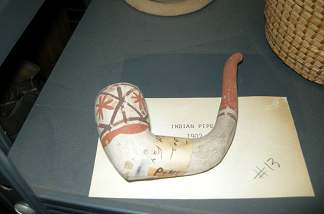 Indian Pipe This is a ceramic pipe of unknown tribal origin. This piece shows possible evidence of cross-cultural contact as the color is indicative of pueblo pottery but the shape is not similar to other examples. Its shape is due to the possible copying of European style pipe by a native artist.
Indian Pipe This is a ceramic pipe of unknown tribal origin. This piece shows possible evidence of cross-cultural contact as the color is indicative of pueblo pottery but the shape is not similar to other examples. Its shape is due to the possible copying of European style pipe by a native artist. -
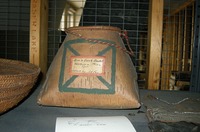 Basket This basket, of unknown tribal origin, is from Minnesota and collected by A. H. Fay. Baskets from this region were made of White Birch bark that was harvested by the tribal groups of the region. White Birch Bark was valuable in its use for basket making due to its durability and that it was waterproof.
Basket This basket, of unknown tribal origin, is from Minnesota and collected by A. H. Fay. Baskets from this region were made of White Birch bark that was harvested by the tribal groups of the region. White Birch Bark was valuable in its use for basket making due to its durability and that it was waterproof. -
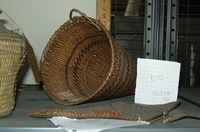 Basket This basket, of unknown tribal origin, is in a conical shape. Baskets similar in shape to these are often used as load bearing baskets, meant for the transport of objects on one's back. Though the tribal origin is unknown, this piece was collected in Carson City, Nevada, along with several other pieces in the collection donated by A. H. Fay. It is possible that Fay frequented a store in the area that sold Indigenous art. alluding to the fact that its origins lie in the tribes of that region. It is possible that it is of the Maidu tribe, as its place of origin lies near the Maidu’s ancestral land.
Basket This basket, of unknown tribal origin, is in a conical shape. Baskets similar in shape to these are often used as load bearing baskets, meant for the transport of objects on one's back. Though the tribal origin is unknown, this piece was collected in Carson City, Nevada, along with several other pieces in the collection donated by A. H. Fay. It is possible that Fay frequented a store in the area that sold Indigenous art. alluding to the fact that its origins lie in the tribes of that region. It is possible that it is of the Maidu tribe, as its place of origin lies near the Maidu’s ancestral land. -
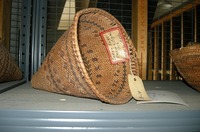 Basket This basket, collected by A. H. Fay in Carson City Nevada, is in the style of a carrying basket that would be placed upon one’s back, though it is too small for practical use. This connection and inference can be made due to its conical shape.
Basket This basket, collected by A. H. Fay in Carson City Nevada, is in the style of a carrying basket that would be placed upon one’s back, though it is too small for practical use. This connection and inference can be made due to its conical shape. -
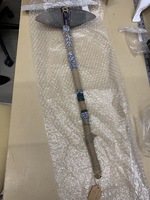 Stone Headed War Club This stone-headed war club, loaned to Lafayette College by Dr. Freeman Ward, is most likely from either the Rosebud Sioux tribe or Oglala Sioux, a branch of the Lakota people of South Dakota, where Dr. Ward conducted much of his surveying work. Though earlier iterations of this beaded club were used for battle, later iterations were intended for ceremonial use. Dr. Ward’s work as a professor in the Geology department at Lafayette likely led him to loan the object to the college for teaching. Unfortunately, it was placed in storage and never returned.
Stone Headed War Club This stone-headed war club, loaned to Lafayette College by Dr. Freeman Ward, is most likely from either the Rosebud Sioux tribe or Oglala Sioux, a branch of the Lakota people of South Dakota, where Dr. Ward conducted much of his surveying work. Though earlier iterations of this beaded club were used for battle, later iterations were intended for ceremonial use. Dr. Ward’s work as a professor in the Geology department at Lafayette likely led him to loan the object to the college for teaching. Unfortunately, it was placed in storage and never returned. -
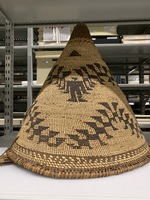 Basket This basket is from the Maidu tribe of Northern California. The basket was most likely used for the transport of objects upon one's back. The V shaped designs on this basket most likely depict the patterns of migrating geese. Baskets such as these are discussed in Basketry Designs of the Maidu Indians of California, written by the collector, Ronald B. Dixon. As he wrote, “Two other designs are representations of birds, the “geese flying ” and the “duck’s wing.” One form of one of these designs is apparently meant for a flock of geese in flight, their triangular order being well shown in the arrangement of the points of the design.”
Basket This basket is from the Maidu tribe of Northern California. The basket was most likely used for the transport of objects upon one's back. The V shaped designs on this basket most likely depict the patterns of migrating geese. Baskets such as these are discussed in Basketry Designs of the Maidu Indians of California, written by the collector, Ronald B. Dixon. As he wrote, “Two other designs are representations of birds, the “geese flying ” and the “duck’s wing.” One form of one of these designs is apparently meant for a flock of geese in flight, their triangular order being well shown in the arrangement of the points of the design.” -
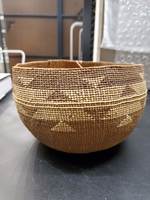 Woven Hat This piece is also an example of basketry from the Hupa tribe of California, though not necessarily used as a container. This is an example of a woven hat, traditionally worn by women. This piece was assumed to be a container like the other baskets in the collection for many years, until recent research into the collection revealed that it was in fact used as a hat.
Woven Hat This piece is also an example of basketry from the Hupa tribe of California, though not necessarily used as a container. This is an example of a woven hat, traditionally worn by women. This piece was assumed to be a container like the other baskets in the collection for many years, until recent research into the collection revealed that it was in fact used as a hat. -
Hat This hat is from the Haida Tribe of Alaska. The animal depicted on this hat is a raven, done in the formline style of the Northwestern Coasts of the Americas. Painted woven hats with formline art, such as this piece, were a common item made and sold by Haida women to tourists in the late nineteenth Century.